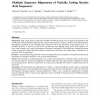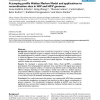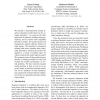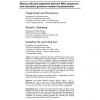266 search results - page 7 / 54 » Comparative modeling without implicit sequence alignments |
BMCBI
2005
13 years 8 months ago
2005
Background: High quality sequence alignments of RNA and DNA sequences are an important prerequisite for the comparative analysis of genomic sequence data. Nucleic acid sequences, ...
BMCBI
2006
2006
A jumping profile Hidden Markov Model and applications to recombination sites in HIV and HCV genomes
13 years 8 months ago
Background: Jumping alignments have recently been proposed as a strategy to search a given multiple sequence alignment A against a database. Instead of comparing a database sequen...
EMNLP
2007
13 years 10 months ago
2007
We describe a discriminatively trained sequence alignment model based on the averaged perceptron. In common with other approaches to sequence modeling using perceptrons, and in co...
BMCBI
2008
13 years 8 months ago
2008
Background: Comparative prediction of RNA structures can be used to identify functional noncoding RNAs in genomic screens. It was shown recently by Babak et al. [BMC Bioinformatic...
IJBRA
2006
13 years 8 months ago
2006
: Stochastic Context-Free Grammars (SCFG) has been shown to be effective in modelling RNA secondary structure for searches. Our previous work (Cai et al., 2003) in Stochastic Paral...




